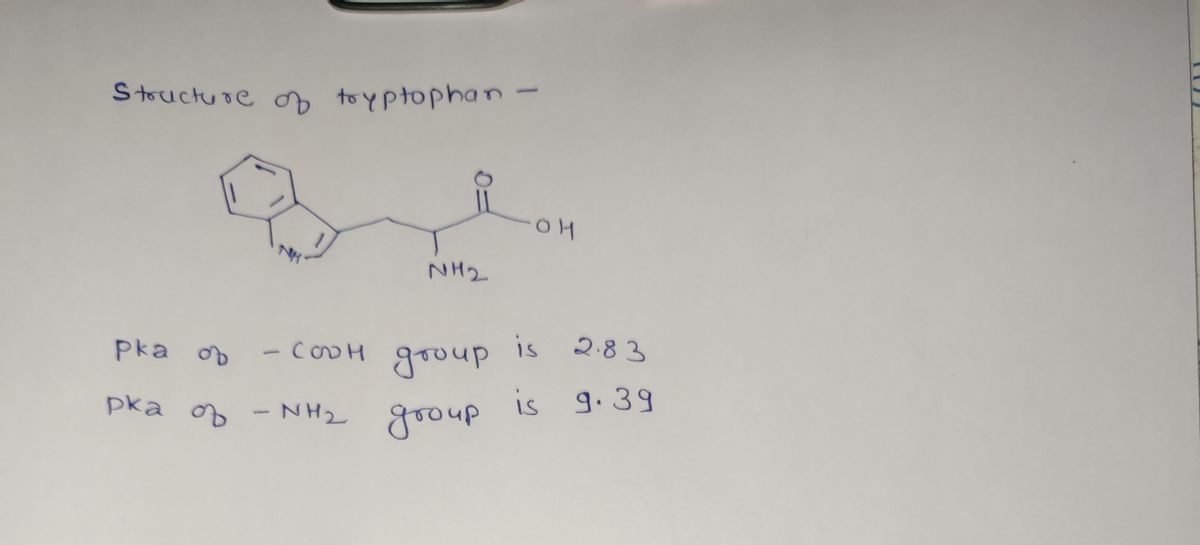2. Below is the structure of tryptophan. HN- tryptophan Draw the molecule in its most common protonation state at pH 7. 0 b. List the criteria for aromaticity. a. Evaluate tryptophan based on these criteria. What is the number of pi electrons? Is tryptophan aromatic? d. Indicate the hybridization of each carbon, nitrogen, and oxygen atom in tryptophan. e. Tryptophan can react with methyl bromide to form the below structure. Draw the mechanism for this reaction, including any relevant intermediate, using the arrow formalism. C. HO, HN- HN- f. Write a suitable rate equation for this reaction. What is the unit of k in your equation? g. h. You increase the pH from 7 to 9. Would you exnect fr decrease, stay the same, or incro of magnitud
2. Below is the structure of tryptophan. HN- tryptophan Draw the molecule in its most common protonation state at pH 7. 0 b. List the criteria for aromaticity. a. Evaluate tryptophan based on these criteria. What is the number of pi electrons? Is tryptophan aromatic? d. Indicate the hybridization of each carbon, nitrogen, and oxygen atom in tryptophan. e. Tryptophan can react with methyl bromide to form the below structure. Draw the mechanism for this reaction, including any relevant intermediate, using the arrow formalism. C. HO, HN- HN- f. Write a suitable rate equation for this reaction. What is the unit of k in your equation? g. h. You increase the pH from 7 to 9. Would you exnect fr decrease, stay the same, or incro of magnitud
Chemistry
10th Edition
ISBN:9781305957404
Author:Steven S. Zumdahl, Susan A. Zumdahl, Donald J. DeCoste
Publisher:Steven S. Zumdahl, Susan A. Zumdahl, Donald J. DeCoste
Chapter1: Chemical Foundations
Section: Chapter Questions
Problem 1RQ: Define and explain the differences between the following terms. a. law and theory b. theory and...
Related questions
Question
please solve asap

Transcribed Image Text:2.
Below is the structure of tryptophan.
OH
tryptophan
a. Draw the molecule in its most common protonation state at pH 7.O
b.
List the criteria for aromaticity.
Evaluate tryptophan based on these criteria, What is the number of pi electrons? Is
tryptophan aromatic?
d.
C.
Indicate the hybridization of each carbon, nitrogen, and oxygen atom in tryptophan.
Tryptophan can react with methyl bromide to form the below structure. Draw the
mechanism for this reaction, including any relevant intermediate, using the arrow
е.
formalism. -
OH
HN
Write a suitable rate equation for this reaction.
What is the unit of k in your equation?
h. You increase the pH from 7 to 9. Would you expect for rate of product formation to
decrease, stay the same, or increase? If you expect the rate to change, provide an order
of magnitude estimate of by how much. Please explain your reasoning (1 sentence max).
f.
g.
Expert Solution
Step 1

Step by step
Solved in 3 steps with 3 images

Recommended textbooks for you

Chemistry
Chemistry
ISBN:
9781305957404
Author:
Steven S. Zumdahl, Susan A. Zumdahl, Donald J. DeCoste
Publisher:
Cengage Learning

Chemistry
Chemistry
ISBN:
9781259911156
Author:
Raymond Chang Dr., Jason Overby Professor
Publisher:
McGraw-Hill Education

Principles of Instrumental Analysis
Chemistry
ISBN:
9781305577213
Author:
Douglas A. Skoog, F. James Holler, Stanley R. Crouch
Publisher:
Cengage Learning

Chemistry
Chemistry
ISBN:
9781305957404
Author:
Steven S. Zumdahl, Susan A. Zumdahl, Donald J. DeCoste
Publisher:
Cengage Learning

Chemistry
Chemistry
ISBN:
9781259911156
Author:
Raymond Chang Dr., Jason Overby Professor
Publisher:
McGraw-Hill Education

Principles of Instrumental Analysis
Chemistry
ISBN:
9781305577213
Author:
Douglas A. Skoog, F. James Holler, Stanley R. Crouch
Publisher:
Cengage Learning

Organic Chemistry
Chemistry
ISBN:
9780078021558
Author:
Janice Gorzynski Smith Dr.
Publisher:
McGraw-Hill Education

Chemistry: Principles and Reactions
Chemistry
ISBN:
9781305079373
Author:
William L. Masterton, Cecile N. Hurley
Publisher:
Cengage Learning

Elementary Principles of Chemical Processes, Bind…
Chemistry
ISBN:
9781118431221
Author:
Richard M. Felder, Ronald W. Rousseau, Lisa G. Bullard
Publisher:
WILEY